Over the years, families have discovered a range of meaningful ways to commemorate the memory of their loved ones. One such approach is the thoughtful placement of items at their headstones.
Adorning gravesites not only adds a personal touch, infusing the memorial with its own distinct significance, but also offers solace and connection to grieving families.
In the following sections, we explore six common headstone decorations and their symbolic meanings.
Flowers on Graves
Flowers are what we see most often when visiting cemetery gravesites.
The practice of leaving flowers at graves began thousands of years ago when the ancient Greeks would honor fallen warriors. They believed that if the flowers rooted into the ground and grew from the gravesite, it was a sign that the fallen had found peace.
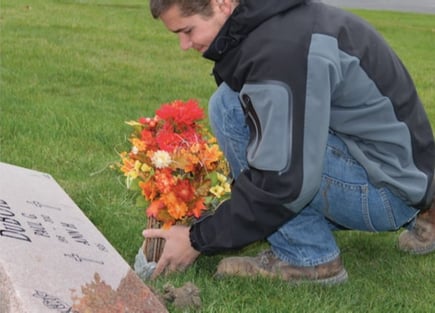
In more recent history, Decoration Day was started three years after the Civil War as a time for American citizens to decorate the graves of fallen soldiers with flowers. Those in charge of Decoration Day chose to celebrate in the spring on May 30 because they wanted to make sure the greatest number of flowers were in bloom across the country. Today, we call Decoration Day Memorial Day.
>>> Related Resource: Buying Graveside Flowers: Everything You Need to Know
Memorial Flower Cross
Crafting and placing a handcrafted memorial flower cross at the resting place of your beloved is a beautiful way to honor their life and acknowledge the spiritual voyage that lies ahead. This gesture not only pays tribute to your loved one but also holds its own symbolism.
Each bloom carries its own message, allowing you to convey specific sentiments. For instance, white flowers symbolize purity and peace, while red ones express love and respect. Yellow blooms radiate warmth and friendship, while pink signifies admiration and gratitude.
>>> Related Resource: 17 Flower Meanings and the Best Time to Send Them
Stones and Rocks on Headstones
Besides flowers, the most common items left on graves are stones and rocks. Although originally a Jewish custom, it is now a practice embraced by all faiths.
Believe it or not, there is a difference between leaving stones versus rocks at a gravesite.
For thousands of years, people memorialized their loved ones by burying and stacking stones—also known as cairns—on top of their graves to mark the burial site and protect them from animals.

Today, leaving rocks on a grave is a way of continuing this tradition to commemorate loved ones. Rocks serve as an easy and small way for anyone to show they were at the cemetery to visit and honor their loved ones.
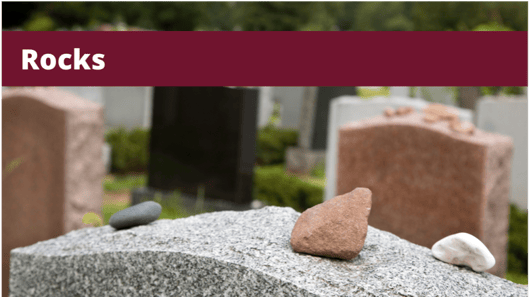 The Jewish religion uses the placement of a rock or pebble on a headstone to keep the soul of the deceased “where it belongs.”
The Jewish religion uses the placement of a rock or pebble on a headstone to keep the soul of the deceased “where it belongs.”
Coins on Headstones
Coins are often left at gravesites, primarily with military connections. It's common in American cemeteries for veterans to leave coins on the graves of their fallen comrades. Each coin carries a specific message:
- Pennies signify a visit.
- Nickels denote shared training.
- Dimes symbolize service together.
- Quarters indicate presence during the veteran's passing.
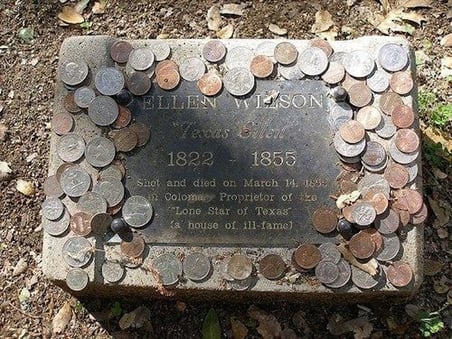
Photo Credit: The Wild Geese
While the origin of this practice remains uncertain, it is believed to have begun during the Vietnam War as a non-political way to show appreciation for the soldier's service. These coins are typically collected and used to support cemetery maintenance or future veteran funerals.
In addition to military significance, coins at gravesites are also associated with superstitions. One such tradition harks back to Greek mythology, where Charon, the ferryman of Hades, requires payment to transport a soul across the river separating the living from the deceased.
Another superstition ties coins to the Donnelly family, suggesting that leaving a coin on their tombstone while making a wish will grant that wish. This belief has expanded to include the idea that leaving a penny on a loved one's headstone may also result in the fulfillment of a wish.
Grave Blankets for Headstones
Grave blankets are another form of cemetery symbolism—and no, we aren’t referring to a quilt placed on your loved one’s gravesite. It is actually an evergreen arrangement woven into a natural blanket that can be laid out over a grave.
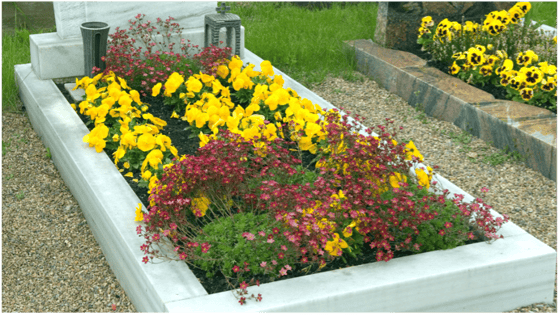 Brought over by Scandinavian settlers in that region, grave blankets are traditionally used in the Midwest. They are usually placed on gravesites before the first snow to serve as a symbolic gesture to tuck in a loved one and keep them warm during the winter.
Brought over by Scandinavian settlers in that region, grave blankets are traditionally used in the Midwest. They are usually placed on gravesites before the first snow to serve as a symbolic gesture to tuck in a loved one and keep them warm during the winter.
Headstone Saddles
Similar to a grave blanket, headstone saddles serve as another evergreen option for memorials. As the name implies, a memorial or headstone saddle is like a horse saddle that sits on top of a memorial.
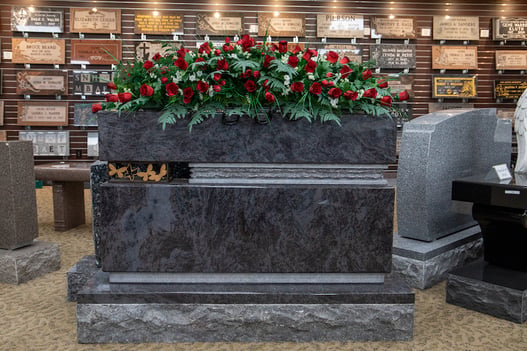
They are designed for upright monuments, which have an elevated, flat surface to place the saddle upon.
With the help of Styrofoam or another material, an entire flower arrangement will stay put in the saddle and not be blown away in the wind. The device also is adhered to the stone to ensure it will not shift or fall from different weather conditions.
Create Your Own Cemetery Symbolism
If you’re interested in learning more about cemetery symbolism or wish to explore additional memorialization possibilities, consider subscribing to our blog. By doing so, you'll receive valuable resources directly delivered straight to your inbox.




